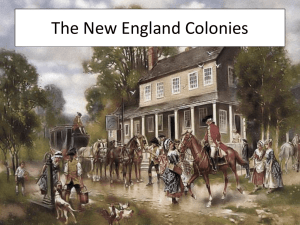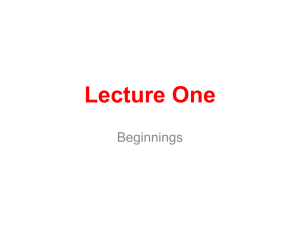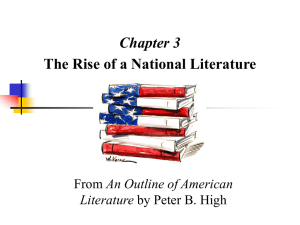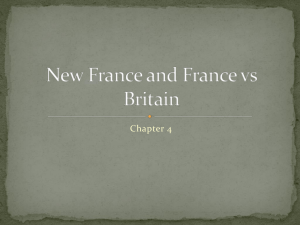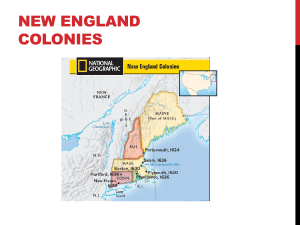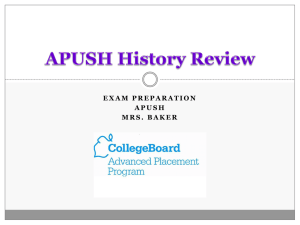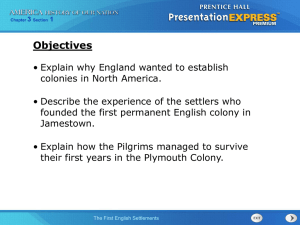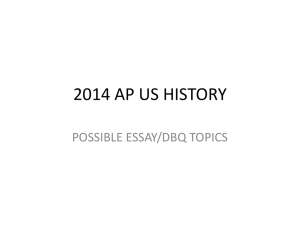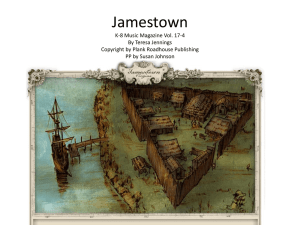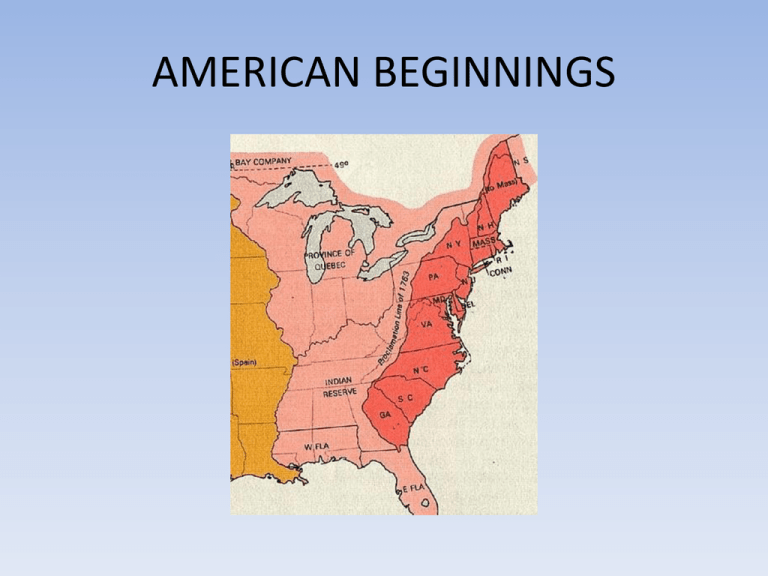
AMERICAN BEGINNINGS
THE COMING OF THE ENGLISH
• 17th century No. Am., was an unstable and
dangerous environment.
• Diseases decimated Indian and settler
populations alike.
• Colonies were racked by religious, political, and
economic tensions and drawn into imperial wars
and conflict with Indians.
• They remained dependent on the Mother
Country for protection and economic assistance.
THE COMING OF THE ENGLISH
• Without sustained immigration, most
settlements would have collapsed.
• With a population of between 4 million and 5
million, about half of Spain and a quarter of
France, England produced a far larger number
of men, women, and children willing to brave
the dangers of emigration to the New World.
• In large part, this was because economic
conditions in England were so bad.
THE COMING OF THE ENGLISH
• Between 1607 and 1700
over a half a million
people left England.
• No. Am., was not the
destination of the
majority of the emigrants.
• But the population of
England’s mainland
colonies quickly
outstripped that of its
rivals.
THE COMING OF THE ENGLISH
• VA and MD = 120,000
settlers.
• New England = 21,000
settlers.
• The Middle Colonies
(NY, NJ, PA) = 23,000
settlers.
• Although the arrivals to
NE and the Middle
Colonies included
families, the majority of
newcomers were
young, single men from
the bottom rungs of
English society who had
little to lose by
emigrating.
IDENTURED SERVANTS
INDENTURED SERVANTS
• Settlers who could pay
their own passage
arrived in America as
free persons.
• Most quickly acquired
by land.
• However 2/3 of English
settlers came as
indentured servants.
INDENTURED SERVANTS
• Indentured servants voluntarily surrendered their freedom for
a specific period of time – usually 5 to 7 years – in exchange
for passage to America.
• Servants”
– Could be bought and sold
– Could marry without permission of their owner
– Were subject to physical punishment
– Saw their obligation to labor enforced by the courts
– If women servants became pregnant, her length of
indenture would be increased
INDENTURED SERVANTS
• But unlike slaves,
servants could look
forward to a release
from bondage.
• Assuming they survived
their period of labor,
servants would receive
payment known as
“freedom dues” and
become free members
of society.
INDENTURED SERVANTS
• For most of the 17th century, indentured
servitude was not a guaranteed route to
economic autonomy.
• Many did not live to end of their terms.
• Freedom dues many times were so meager that
they did not enable recipients to acquire land.
• Many found life in the New World less appealing
than they had anticipated.
• Many ran away.
ENGLISHMEN AND INDIANS
ENGLISHMEN AND INDIANS
• Land in No. Am., was already occupied.
• The arrival of English settlers presented the
native inhabitants of eastern No. Am., with
the greatest crisis in their history.
• Unlike the Spanish and French, the English
were chiefly interested in displacing the
Indians and settling on their land.
ENGLISHMEN AND INDIANS
• English communities were
obstinately separate from
their Indian neighbors.
• Despite their insistence
that Indians had no real
claim to the land since
they did not cultivate or
improve it, most colonial
authorities in practice
recognized Indians’ title
based on occupancy.
ENGLISHMEN AND INDIANS
• The English acquired land
through purchase, often
in treaties forced upon
the Indians after they had
suffered military defeat.
• To keep the peace, some
colonial govts., tried to
prevent the private
seizure of Indian lands, or
they declared certain
areas off limits to settlers.
ENGLISHMEN AND INDIANS
• These measures were
rarely enforced and
ultimately proved
ineffective.
• New settlers and freed
servants sought land for
themselves, and those
who established
families in America
needed land for their
children.
ENGLISHMEN AND INDIANS
• The 17th century was marked by recurring
warfare between colonists and Indians.
• These conflicts generated a strong feeling of
superiority and separateness among the
colonists.
• Over time the English displaced the original
inhabitants of eastern No. Am., more thoroughly
than any other European empire.
• When the English landed in Jamestown, I 1607,
the lives of Indians was powerfully altered.
SETTLING THE CHESAPEAKE: THE
JAMESTOWN COLONY
SETTLING THE CHESAPEAKE: THE
JAMESTOWN COLONY
• Jamestown was founded
in 1607.
• The early history of the
colony was not promising.
• The colony’s leadership
changed repeatedly, its
inhabitants suffered a
high death-rate, and
supplies from England
proved inadequate.
• The VA. Company was
hoping to make a huge
profit from the colony.
ENGLISHMEN AND INDIANS
• The settlers included
small farmers, laborers,
and sons of the English
gentry and high-skilled
craftsmen who preferred
to prospect for gold
rather than farm.
• Jamestown lay beside a
swamp containing
malaria-carrying
mosquitoes.
• Disease and the lack of
food took a heavy toll.
SETTLING THE CHESAPEAKE: THE
JAMESTOWN COLONY
• By the end of 1607, the original population of
104 had fallen to 52.
• New arrivals (including the first two women in
1608) brought the population up to 400 by
1609.
• 1610: After a winter long remembered as the
“starving time,” only 65 settlers remained
alive.
SETTLING THE CHESAPEAKE: THE
JAMESTOWN COLONY
• At one point, the
survivors abandoned the
colony and sailed for
England.
• They were intercepted
and persuaded to return
to VA by ships carrying a
new governor, 250
colonists and supplies.
• 1616: About 80% of the
immigrants who arrived
in the first decade were
dead.
SETTLING THE CHESAPEAKE: THE
JAMESTOWN COLONY
• Only vigorous military
discipline held the colony
together.
• John Smith imposed a
regime of forced labor on
company lands.
• “He who will not work,
will not eat,” Smith
declared.
• His autocratic mode of
governing alienated many
colonists.
SETTLING THE CHESAPEAKE: THE
JAMESTOWN COLONY
• After being injured in an
accidental gunpowder
explosion in 1609,
Smith was forced to
return to England.
• But his immediate
successors continued
his iron rule.
SETTLING THE CHESAPEAKE: THE
JAMESTOWN COLONY
• The VA Company slowly realized that for the
colony to survive it would have to abandon its
search for gold, grow its own food, and find a
marketable commodity.
• It would also have to attract more settlers.
• 1618: New policies were adopted that
powerfully shaped VA’s development.
SETTLEING THE CHESAPEAKE: THE
JAMESTOWN COLONY
• The company introduced
the headright system –
awarding 50 acres of land
to a colonist who paid his
own or another’s
passage.
• Thus, anyone who
brought in a sizable
number of servants
would immediately
acquire a large estate.
SETTLING THE CHESAPEAKE: THE
JAMESTOWN COLONY
• In place of the governor’s militaristic regime, a
“charter of grants and liberties” was issued.
• This included the establishment of the House
of Burgesses – the first elected assembly in
Colonial America.
• But the House of Burgesses was hardly a
model of democracy.
SETTLING THE CHESAPEAKE: THE
JAMESTOWN COLONY
• Only landowners could
vote.
• The Company and its
appointed governor
retained the right to
nullify any measure the
body adopted.
• But its creation
established a political
precedent that all English
colonies would eventually
follow.
SETTLING THE CHESAPEAKE: THE
JAMESTOWN COLONY
• 1619: The first 20 blacks
arrived in VA on a Dutch
vessel.
• The full significance of
this event would not be
immediately apparent.
• But it laid the foundation
for a society that would
be dominated
economically and
politically by slave-owning
planters.
POWHATAN’S WORLD
POWHATAN’S WORLD
• When the English arrived in Jamestown, they
landed in a region inhabited by some 15,000
to 25,000 Indians in numerous small
agricultural villages.
• Most acknowledged the rule of Powhatan – a
shrewd and forceful leader.
• Powhatan quickly realized the advantages of
trade with the newcomers.
POWHATAN’S WORLD
• The VA Company
instructed its colonists to
treat the local Indians
kindly and to try to
convert them to
Christianity.
• Realizing that the
colonists depended on
the Indians for food, John
Smith tried to stop
settlers from seizing
produce from nearby
villages.
POWHATAN’S WORLD
• In the first two years of Jamestown’s
existence, relations with Indians were mostly
peaceful.
• Smith’s departure raised tensions between the
two groups.
• Sporadic conflict began in 1610, with the
English massacring villages indiscriminately
and destroying Indian crops.
POWHATAN’S WORLD
• 1614: Peace was restored
when the English colonist
John Rolfe married
Pocahontas, reputedly
the favorite among
Powhatan’s many
children.
• Having converted to
Christianity, she
accompanied Rolfe back
to England.
THE UPRISING OF 1622
THE UPRISING OF 1622
• Once it became clear
that the English were
interested in
establishing a
permanent and
constantly expanding
colony conflict with
local Indians was
inevitable.
• The peace of 1614
ended in1622.
THE UPRISING OF 1622
• Powhatan’s brother and
successor,
Opechancanough, led a
surprise attack that in a
day wiped out ¼ of VA’s
settler population of
1,200.
• The surviving colonists
organized themselves into
military bands, which
then massacred scores of
Indians and devastated
their villages.
THE UPRISING OF 1622
• Indians remained a significant presence on
VA., and trade continued throughout the
century.
• But the unsuccessful uprising of 1622 shifted
the balance of power.
• The settlers’ supremacy was reinforced in
1644 when a last desperate rebellion, led by
Opechancanough, was crushed after causing
the deaths of some 500 colonists.
THE UPRISING OF 1622
• VA., forced a treaty on the surviving Indians
that acknowledged their subordination to the
govt., at Jamestown and required to move to
tribal reservations to the west and not enter
areas of European settlement without
permission.
• Settlers spreading inland into the VA.,
countryside continued to seize Indian land.
THE UPRISING OF 1622
• The destruction caused by
the uprising of 1622 was the
last in a series of blows
suffered by the VA
Company.
• 1624: The company lost its
charter and VA., became
the first royal colony, its
governor now appointed by
the Crown.
• VA., had failed to
accomplish its goals for
either the Company or the
settlers.
A TOBACCO COLONY
A TOBACCO COLONY
• The govt., in London for years paid little
attention to VA. (salutary neglect)
• The local elite, not a faraway company,
controlled the colony’s development.
• The elite was growing in wealth and power
thanks to the cultivation of tobacco which was
introduced by John Rolfe.
A TOBACCO COLONY
• Tobacco became VA’s
substitute for gold.
• It enriched an emerging
class of tobacco
planters, was well as
members of colonial
govt., who assigned
good land to
themselves.
• The Crown also profited
form customs duties.
A TOBACCO COLONY
• 1624: Over 200,000
pounds were being
grown, producing
startling profits for
landowners.
• 1664: The crop totaled
15 million pounds, and
it doubled again in the
1680s.
A TOBACCO COLONY
• The expansion of tobacco cultivation also led to
an increased demand for field labor.
• This need for labor was met by young, male
indentured servants.
• Despite harsh conditions of work in the tobacco
fields, high death rate, and laws mandating
punishments from whipping to an extension of
the service for those who ran away or were
unruly, the abundance of land continued to
attract migrants.
A TOBACCO COLONY
• Of the 120,000 English immigrants who entered
the Chesapeake region, ¾ came as servants.
• VA’s., white society increasingly came to
resemble that of England, with a wealthy landed
gentry at the top, a group of small farmers in the
middle, and an army of poor laborers at the
bottom.
• 1700: The region’s white population had grown to
nearly 90,000.
THE MARYLAND EXPERIMENT
THE MARYLAND EXPERIMENT
• Although it began under different sponsorship
and remained much smaller than VA during
the 17th century, the second Chesapeake
colony, Maryland (MD) followed a similar
course of development.
• Tobacco came to dominate the economy and
tobacco planters the society.
• But in other ways, MD’s., history was strikingly
different.
THE MARYLAND EXPERIMENT
• 1632: MD., was establish as a
proprietary colony.
• A grant of land and authority
was given to Cecilius Calvert.
• The charter made him the
proprietor of the colony and
gave him the power to control
trade and the right to initiate
legislation, with an elected
assembly confined to
approving or disapproving his
proposals.
• Calvert imagined MD., as a
feudal domian.
THE MARYLAND EXPERIMENT
• Land would be laid out
in manors with owners
paying “quitrents” to
the proprietor.
• Calvert disliked
representative
institutions and
believed ordinary
people should not
meddle in govt., affairs.
THE MARYLAND EXPERIMENT
• But the charter guaranteed to colonists “all
privileges, franchises and liberties” of
Englishmen.
• This undoubtedly included the idea of govt.,
limited by law.
• Here was a recipe for conflict, and MD., had
more than its share during the 17th century.
THE MARYLAND EXPERIMENT
• Adding to the instability
in the colony, Calvert, a
Catholic, envisioned
MD., as a refuge for
persecuted Catholics in
England.
• He hope that Catholics
and Protestants could
live in a harmony
unknown in Europe.
THE MARYLAND EXPERIMENT
• The first group of 130 colonists included a
number of Catholic gentlemen and two
priests.
• But Protestants always formed a majority of
settlers.
• Most came as indentured servants but others
took advantage of MD’s., generous headright
system to acquire land by transporting
workers to the colony.
THE MARYLAND EXPERIMENT
• The combination between Protestants and
Catholics, the rapid expansion of tobacco
planting, and anti-proprietary feeling
produced a series of violent episodes in mid
17th century MD.
• MD., in the 1640s verged on total anarchy.
• Protestants dominated the assembly which
was elected by “freemen” without, at first, a
property qualification
THE MARYLAND EXPERIMENT
• To stabilize the colony and
attract more settlers, Calvert
appointed a Protestant
governor and offered refuge to
Dissenters (Protestants who
belonged to denominations
other than the Anglican
Church).
• 1649: MD., adopted an Act
Concerning Religion which
institutionalized the principle
of toleration that had
prevailed from the colony’s
beginning.
• All Christians were guaranteed
the “free exercise” of religion.
THE MARYLAND EXPERIMENT
• But the Act did not establish religious liberty
in a modern sense, since it punished those
who denied the divinity of Jesus Christ or the
doctrine of the Holy Trinity.
• A Jewish doctor was arrested under the Act’s
provisions.
• Nonetheless the Act was a milestone in the
history of religious freedom in Colonial
America.
THE MARYLAND EXPERIMENT
• Turmoil still prevailed.
• 1650s: MD., was placed
under the control of a
Protestant council, which
repealed the Toleration
Act and forbade Catholics
from openly practicing
their religion.
• 1657: Calvert’s authority
was restored and with it
MD’s., experiment in
religious freedom.
THE NEW ENGLAND WAY: THE RISE OF
PURITANISM
THE NEW ENGLAND WAY: THE RISE OF
PURITANISM
• A very different social order emerged in 17th
century New England.
• The early history of N.E., is connected to the
religious movement known as Puritanism
which arose in England late in the 16th
century.
• Puritanism came to define a set of religious
beliefs and a view of how society should be
organized.
THE NEW ENGLAND WAY: THE RISE OF
PURITANISM
• All Puritans shared the conviction that the
Church of England retained too many
elements of Catholicism.
• Many rejected the Catholic structure of
religious authority.
• These Puritans were called Congregationalists.
THE NEW ENGLAND WAY: THE RISE OF
PURITANISM
• Puritans followed the
teachings of John Calvin
– a French born Swiss
theologian.
• He believed that the
world was divided
between the elect and
the damned.
• He advocated the idea
of predestination.
THE NEW ENGLAND WAY: THE RISE OF
PURITANISM
• A minority of Puritans
became Separatists
(Pilgrims) abandoning
the Church of England
entirely to form their own
independent
denominations.
• When Puritans emigrated
to N.E., they hoped to
escape what they
believed to be religious
and worldly corruptions
of English society.
THE NEW ENGLAND WAY: THE RISE OF
PURITANISM
• John Winthrop stated
that the Puritans would
be a “city set on a hill,”
a Bible commonwealth
whose influences would
flow back across the
Atlantic and rescue
England from
godlessness and social
decay.
THE NEW ENGLAND WAY: THE RISE OF
PURITANISM
• Puritans came in search
of liberty, especially the
right to worship and
govern themselves in
what they deemed a
truly Christian manner.
• To them, freedom was a
spiritual affair.
THE PILGRIMS AT PLYMOUTH
THE PILGRIMS AT PLYMOUTH
• The first Puritans to
emigrate to America
were a group of
separatists known as
Pilgrims.
• Sept. 1620: The
Mayflower carrying 150
settlers and crew
embarked from England
sailing for VA.
THE PILGRIMS AT PLYMOUTH
• Blown off course,
they did not land in
VA.
• Instead they landed
on Cape Cod.
• Here they
established the
colony of Plymouth.
THE PILGRIMS AT PLYMOUTH
• Before landing, the
Pilgrims leaders drew up
the Mayflower Compact
in which the adult men
going ashore agreed to
obey “just and equal
laws” enacted by
representatives of their
choosing.
• The was the first written
frame of govt., in what is
now known as the USA.
THE PILGRIMS AT PLYMOUTH
• They arrived in an area
whose native population
had recently been
decimated by smallpox.
• They established
Plymouth on a site of an
abandoned Indian village,
whose fields had been
cleared before the
smallpox epidemic and
was ready for cultivation.
• Yet half the settlers died
the first winter.
THE PILGRIMS AT PLYMOUTH
• The colonists survived
with the help of local
Indians especially
Squanto.
• He served as their
interpreter, taught them
where to fish and how to
plant corn.
• He helped in the forging
of an alliance with
Massasoit, a local
Wampanoag chief.
THE PILGRIMS AT PLYMOUTH
• 1621: The Pilgrims
invited their Indian
allies to a harvest
feast celebrating
their survival, the
first thanksgiving.
THE PILGRIMS AT PLYMOUTH
• The Pilgrims hoped to establish a society based
on the lives of the early Christian saints.
• Their govt., rested on the principle of consent,
and voting was not restricted to church members.
• All land was held in common, until 1627, when it
was divided among settlers.
• Plymouth remained an independent colony until
1691 but it was soon overshadowed by
Massachusetts Bay to its north.
THE GREAT MIGRATION:
MASSACHSUETTS BAY COLONY
THE GREAT MIGRATION:
MASSACHUSETTS BAY COLONY
• 1629: The Mass Bay Company was founded by a
group of London merchants who hoped to
further the Puritan cause and turn profit through
trade with the Indians.
• 1629-1641: Some 21,000 Puritans emigrated to
MA. – this is known as the Great Migration.
• This flow of population represented less than
one-third of English emigration in the 1630s.
• But the Great Migration established the basis for
a stable and thriving society.
THE GREAT MIGRATION:
MASSACHUSETTS BAY COLONY
• The settling of N.E. was
unique.
• Most settlers arrived in
Mass Bay as families.
• They came for many
reasons: desire to escape
religious persecution,
anxiety about the future of
England, and the prospect
of economic betterment.
• The number of men and
women was equally
balanced.
THE GREAT MIGRATION:
MASSACHUSETTS BAY COLONY
• Because of the even sex
ratio and N.E.’s healthier
climate, the population
grew rapidly every 27 years.
• 1700: N.E.’s white
population of 91,000
outnumbered that of both
the Chesapeake and West
Indies.
• Nearly all were descendants
of those who crossed the
Atlantic during the Great
Migration.
GOVERNMENT AND SOCIETY IN
MASSACHUSETTS BAY COLONY
GOVERNMENT AND SOCIETY IN
MASSACHUSETTS BAY COLONY
• Unlike the dispersed plantation-centered
society of the Chesapeake, the leaders of
Mass Bay organized the colony in selfgoverning towns.
• Groups of settlers received a large land grant
from the colony’s govt., and then subdivided
it, with residents awarded lots in a central
area and land on the outskirts for farming.
GOVERNMENT AND SOCIETY IN
MASSACHUSETTS BAY COLONY
• Much land remained in commons, either for
collective use or to be divided among later
settlers or the sons of the town’s founders.
• Each town had its own Congregational Church.
• Each town, according to a law of 1647, was
required to establish a school, since the ability
to read the Bible was central to Puritan belief.
GOVERNMENT AND SOCIETY IN
MASSACHUSETTS BAY COLONY
• To train an educated
ministry, Harvard
College, was established
in 1636.
• 1638: The first printing
press in English America
was established in
Cambridge.
GOVERNMENT AND SOCIETY IN
MASSACHUSETTS BAY COLONY
• The govt., of Mass Bay
reflected the Puritans’
religious and social views.
• The shareholders of the
Mass Bay Company
emigrated to America,
taking with the charter
with them and
transforming a
commercial document
into a form of govt.
GOVERNMENT AND SOCIETY IN
MASSACHUSETTS BAY COLONY
• At first, the eight shareholders chose the men
who ruled the colony.
• 1634: A group of deputies elected by freemen
was added to form a single ruling body called
the General Court.
• 1644: Company officers and elected deputies
were divided in two legislative houses.
• The freemen of the colony elected their
governor.
GOVERNMENT AND SOCIETY IN
MASSACHUSETTS BAY COLONY
• The principle of consent
was central to Puritanism.
• Church govt., was
decentralized.
• Churches were formed by
voluntary agreement
among members, who
elected the minister.
• No important church
decision was made
without the agreement of
the male members.
GOVERNMENT AND SOCIETY IN
MASSACHUSETTS BAY COLONY
• Towns governed
themselves and local
officials, delegates to
the General Court, and
the colonial governor
were elected.
• Puritans, however, were
hardly believers in
equality.
GOVERNMENT AND SOCIETY IN
MASSACHUSETTS BAY COLONY
• Church membership was a restrictive category.
• Anyone could worship but to be a full member of
the church required demonstrating that one had
experienced divine grace and could be considered
a “visible saint” usually by testifying about a
conversion experience.
• Voting in colony-wide elections was limited to
men who had been accepted as church members.
• This requirement at first made for a broad
electorate, especially compared to England.
GOVERNMENT AND SOCIETY IN
MASSACHUSETTS BAY COLONY
• But as time went on it meant that a smaller
and smaller percentage of the population
controlled the govt.
• Puritan democracy was for those within the
circle of church membership.
• Those outside the boundary occupied a
secondary place in the Bible Commonwealth.
NEW ENGLANDERS DIVIDED
NEW ENGLANDERS DIVIDED
• Puritans exalted individual judgment.
• That is why reading the Bible was important.
• Modern ideas such as individualism, privacy, and
personal freedom would have struck the Puritans as
quite strange.
• They considered too much emphasis on the “self” as
dangerous to social harmony and community stability.
• In N.E, residents carefully monitored each others
behavior and chastised or expelled those who violated
communal norms.
• Tolerance of difference was not high on the list of
Puritan values.
NEW ENGLANDERS DIVIDED
• Differences of opinion about how to organize
a Bible Commonwealth emerged from the
founding of Massachusetts Bay.
• With its emphasis on individual
interpretations of the Bible, Puritanism
contained the seeds of it own fragmentation.
• The first sustained criticism of the existing
order came from the young minister Roger
Williams who arrived in Mass Bay in 1631.
ROGER WILLIAMS AND THE
FOUNDING OF RHODE ISLAND
• Williams began to insist
that Mass Bay’s
congregations withdraw
from the Church of
England and the church
and state be separated.
• “Soul liberty,” he believed
required that individuals
be allowed to follow their
consciences wherever
they led.
ROGER WILLIAMS AND THE
FOUNDING OF RHODE ISLAND
• Williams also believed
that any law-abiding
citizen should be
allowed to practice
whatever form of
religion he chose.
• If the govt., forbade
religious liberty then it
violated the principle
that genuine religious
faith is voluntary.
ROGER WILLIAMS AND THE
FOUNDING OF RHODE ISLAND
• His aim was to strengthen religion not weaken it.
• He insisted that the embrace of govt., corrupted
the purity of Christian faith and drew believers
into endless religious wars.
• He rejected the conviction that Puritans were an
elect people on a divine mission to spread the
true faith.
• He denied that God had singled out any group as
special favorites.
ROGER WILLIAMS AND THE
FOUNDING OF RHODE ISLAND
• 1636: Williams was
banished from Mass
Bay.
• He and his followers
moved south and
established the colony
of Rhode Island.
• R.I., became a beacon
of religious freedom.
ROGER WILLIAMS AND THE
FOUNDING OF RHODE ISLAND
• R.I., had no established church.
• No religious qualification for voting until the
18th century.
• Its’ govt., was also more democratic.
• The assembly was elected twice a year, the
governor annually, and town meetings were
held more frequently than elsewhere in N.E.
THE TRIALS OF ANNE HUTCHINSON
THE TRIALS OF ANNE HUTCHINSON
• More threatening to the
Puritan establishment
was Anne Hutchinson.
• She arrived in Mass Bay in
1634.
• She began to hold
meetings in her home,
where she led religious
discussions among men
and women, including a
number of prominent
merchants and officials.
THE TRIALS OF ANNE HUTCHINSON
• In her view, salvation was
God’s gift to the elect and
could not be earned by human
effort.
• Most Puritans also believed
this.
• But she charged that nearly all
the ministers in Mass Bay were
guilty of faulty preaching for
distinguishing “saints” from
the damned by activities such
as church attendance and
moral behavior rather than by
an inner stare of grace.
THE TRIALS OF ANNE HUTCHINSON
• Her critics denounced
Hutchinson for
practicing Antinomianism – a term for
putting one’s own
judgment or faith above
both human law and
the teachings of the
church.
• 1637: She was placed
on trial for sedition.
THE TRIALS OF ANNE HUTCHINSON
• She more than held her
own when questioned
by Puritan leaders.
• But when she spoke of
divine revelations, of
God speaking to her
directly instead of
through ministers or the
Bible, she violated
Puritan doctrine and
sealed her own fate.
THE TRIALS OF ANNE HUTCHINSON
• Hutchinson and a
number of her followers
were banished.
• Her family made its way
to R.I. and settled in
Portsmouth.
• They moved to Long
Island where she and
most of her relatives
perished during an
Indian war.
THOMAS HOOKER AND THE
FOUNDING OF CONNECTICUT
THOMAS HOOKER AND THE
FOUNDING OF CONNECTICUT
• 1636: Minister Thomas
Hooker established a
settlement at Hartford.
• Its govt., embodied in
the Fundamental
Orders of 1639, 2w
modeled on that of MA.
• But men did not have to
be church members to
vote.
THOMAS HOOKER AND THE
FOUNDING OF CONNECTICUT
• Quite different was the colony of New Haven,
founded in 1638 by emigrants who wanted a
an even closer connection connection
between church and state.
• 1642: Hartford and New Haven received a
royal charter that united them as the colony of
Connecticut.
PURITANS AND INDIANS
PURITANS AND INDIANS
• N.E., like other colonies, had to deal with the
difficult problem of relations with the Indians.
• The native population of N.E., numbered
perhaps 100,000 when the Puritans arrived.
• But because of recent epidemics, the migrants
encountered fewer Indians near the coast
than in other parts of eastern North America.
• In areas of European settlement, colonists
quickly outnumbered the native population.
PURITANS AND INDIANS
• Some settlers, like
Roger Williams, sought
to treat the Indians with
fairness and justice.
• He learned complex
Indian languages.
• He insisted that the king
had no right to grant
land already belonging
to someone else.
PURITANS AND INDIANS
• John Winthrop believed
uncultivated land could
legitimately be taken by
colonists.
• He recognized the
benefits of buying land
rather than seizing it.
• But he insisted that such
purchases must carry
with them Indian
agreement to submit to
English authority and pay
tribute to the colonists.
PURITANS AND INDIANS
• To N.E., leaders, the Indians represented both
savagery and temptation.
• In Puritan eyes, they resembled Catholics with
their false gods and deceptive rituals.
• They enjoyed the wrong kind of freedom.
• Winthrop condemned as undisciplined
“natural liberty” rather than the “moral
liberty” of the civilized Christian.
PURITANS AND INDIANS
• 1642: The General Court of CT., set a penalty of 3
years at hard labor for any colonist who
abandoned “godly society” to live with Indians.
• Puritans announced that they intended to
convert the Indians but they did nothing in the
first two decades of settlement to accomplish
this.
• They saw Indians as an obstacle to be pushed
aside, rather than as potential converts.
PURITANS AND INDIANS
• Indians in N.E., lacked a
paramount chief like
Powhatan.
• Coastal Indians initially
sought to forge alliances
with the newcomers to
enhance their position
against inland rivals.
• But conflict between
white settlers and Indians
was inevitable.
THE PEQUOT WAR
THE PEQUOT WAR
• The turning point
came in 1637 when
several CT., settlers
were killed by
Pequots – a powerful
tribe who controlled
the southern N.E.,
fur trade and
exacted tribute from
other Indians.
THE PEQUOT WAR
• A force of CT., and MA.,
soldiers, augmented by
Narragansett allies,
surrounded the Pequot
village in Mystic and set it
ablaze.
• Over 500 men, women and
children lost their lives in
the massacre.
• By the end of the war, most
of the Pequot had been
exterminated or sold into
Caribbean slavery.
THE PEQUOT WAR
• The treaty that restored
peace decreed that the
Pequot name be wiped
from the historical record.
• The destruction of the
Pequots not only opened
the CT. River valley to
white settlement but also
persuaded other Indians
that the newcomers
possessed a power that
could not be resisted.
THE PEQUOT WAR
• The colonists ferocity shocked their Indian allies,
who considered European military practices
barbaric.
• A few Puritans agreed.
• But to most Puritans the defeat of a “barbarous
nation” by the “sword of the Lord” offered
further proof that they were on a sacred mission
and that Indians were unworthy of sharing N.E.,
with the visible saints of the church.
THE NEW ENGLAND ECONOMY
THE NEW ENGLAND ECONOMY
• The leaders of N.E., prided themselves on the
idea that religion was the primary motivation
for emigration.
• But economic motives were hardly
unimportant to Puritans.
• One promotional pamphlet of the 1620s
spoke of N.E., as a place “where religion and
profit jump together.”
THE NEW ENGLAND ECONOMY
• Most Puritans came from East
Anglia an internationally
known cloth-producing region.
• East Anglia was suffering from
a series of poor harvests and
the dislocations caused by a
decline in the cloth trade.
• Many emigrants were
weavers, tailors, or farmers.
• While they were leaving a
depressed region, they were
relatively well-off.
• They sought religious liberty
and economic advancement.
THE NEW ENGLAND ECONOMY
• Lacking a market stable
staple crop like sugar or
cotton, New Englanders
turned to fishing and
timber for exports.
• But the economy
centered on family
farms producing their
own food for their own
use and a small
marketable surplus.
THE NEW ENGLAND ECONOMY
• Although the Body of Liberties of 1641 made
provision for slavery in the Bible
Commonwealth, there were very few slaves in
17th century New England.
• Nor were indentured servants as central to
the economy as in the Chesapeake.
• Most households relied on the labor of their
members including women in the home and
children in the field.
THE NEW ENGLAND ECONOMY
• Wealth was more equally
distributed in N.E., than in
the Chesapeake.
• Most families achieved
the goal of owning their
own land, the foundation
for a comfortable
independence.
• Economic development
produced a measure of
social inequality.
THE NEW ENGLAND COLONY
• N.E., gradually assumed
a growing role within
the British empire
based on trade.
• By the second half of
the 17th century, N.E.,
merchants shipped and
marketed the staples of
other colonies.
THE NEW ENGLAND ECONOMY
• N.E., merchants and
shippers supplied Europe
with fish, timber, and
agricultural produce
gathered at home.
• In Boston, a powerful
class or merchants arose
who challenged some key
Puritan policies, including
the subordination of
economic activity to the
common good.
THE NEW ENGLAND ECONOMY
• Puritans never abandoned the idea that
economic activity should serve the general
welfare.
• But eventually Boston merchants came to
exercise decisive influence in public affairs.
• The govt., of Mass Bay actively promoted
economic development.
• The Puritan experiment would evolve into a
merchant-dominated colonial government.
THE HALF-WAY COVENANT
THE HALF-WAT COVENANT
• In the mid 17th century, some Puritans leaders began to
worry about their society’s growing commercialization
and declining piety.
• 1650: Less than half the population of Boston had been
admitted to full church membership.
• MA., church leaders were forced to deal with a growing
problem – the religious status of the third generation.
• Children of the elect were baptized but never became
full members of the church since they could not
demonstrate the necessary religious commitment or
testify to a conversion experience.
THE HALF-WAY COVENANT
• The Half-Way Covenant of
1662 tried to address this
problem.
• It allowed for the baptism
and kind of “half-way”
membership for
grandchildren of those who
emigrated during the Great
Migration.
• In a significant compromise
of Puritan beliefs, ancestry
not religious conversion
became the pathway to
inclusion among the elect.
THE HALF-WAY COVENANT
• Church membership
remained stagnant.
• 1660s-16707s: Ministers
were castigating the people
for straying away from
Puritan beliefs.
• These warnings called
“jeremiads” interpreted
crop failings and diseases as
signs of divine disapproval
and warned of punishment
to come if N.E., did not
amend its ways.
THE HALF-WAY COVENANT
• Yet hard work and
commercial success in
one’s chosen calling had
always been central to
Puritan beliefs.
• In this sense, the
commercialization of
N.E., was much a
fulfillment of the
Puritan mission in
America as a betrayal.
THE NEW ENGLAND COLONIES
THE NEW ENGLAND COLONIES
• By the middle of the 17th
century, several English
colonies existed along the
Atlantic coast.
• Established as part of an
ad hoc process rather
than arising under any
coherent national plan,
they differed in economic,
political, and social
structure.
THE NEW ENGLAND COLONIES
• In N.E., settlements
centered on small
towns and family farms
while in the Chesapeake
the seeds had been
planted for the
development of
plantation societies
based on unfree labor.
THE NEW ENGLAND COLONIES
• Throughout the colonies, many residents enjoyed
freedoms they had not possessed at home,
especially access to land and the right to worship
as they desired.
• Others found themselves confined to unfree
labor for many years or an entire lifetime.
• The next century would be a time of crisis and
consolidation as the population expanded, social
conflicts intensified, and Britain moved to exert
greater control over its flourishing No. Am.,
colonies.
THE DUTCH EMPIRE
THE DUTCH EMPIRE
• 1609: Two years after the
settlement of Jamestown,
Henry Hudson, and
Englishmen employed by
the Dutch East India
Company, sailed into New
York Harbor searching for
a Northwest Passage to
Asia.
• He claimed the area for
the Netherlands.
THE DUTCH EMPIRE
• 1614: Dutch traders had established an
outpost at Fort Orange, near present day
Albany.
• 1624: The Dutch West India Company settled
colonists on Manhattan Island – paying the
native inhabitants, according to legend, a sum
equivalent to $24.
THE DUTCH EMPIRE
• The Dutch prided
themselves on their
devotion to liberty.
• In the 17th century, they
enjoyed two freedoms:
freedom of the press
and broad religious
toleration.
• The Dutch came to
America to trade, not to
conquer.
THE DUTCH EMPIRE
• The Dutch were less interested in settling the
land than in exacting profits from it.
• Mindful of the Black Legend, the Dutch were
determined to treat the native inhabitants
more humanely than the Spanish.
• Initially, they aimed less to displace or convert
the Indians than to employ them in the
profitable fur trade.
THE DUTCH EMPIRE
• Dutch authorities
recognized Indian
sovereignty over the
land and forbade
settlement in any area
until it had been
purchased.
• But they also required
tribes to make
payments to colonial
authorities.
THE DUTCH EMPIRE
• But New Netherland was
hardly free of conflict with
the Indians.
• The expansionist ambitions
of Gov. William Kieft, who
had in the 1640s began
seizing fertile farmland from
nearby Algonquian Indians,
sparked a three year war
that resulted in the death of
1,000 Indians and over 200
colonists.
FREEDOM IN NEW NETHERLAND
FREEDOM IN NEW NETHERLAND
• Despite the Dutch reputation for cherishing freedom,
New Netherland was hardly governed democratically.
• New Amsterdam, the main population center, was
essentially a fortified military outpost controlled by
appointees of the West India Company.
• Although the governor called on prominent citizens for
advice from time to time, no elected assembly was
established.
• In other ways, however, colonists enjoyed more liberty,
especially in religious freedoms.
• Even their slaves had rights.
FREEDOM IN NEW NETHERLAND
• The Dutch dominated
the Atlantic slave trade
in the 17th century and
they introduced slaves
into New Amsterdam.
• By 1650, the colony’s
500 slaves
outnumbered those in
the Chesapeake.
FREEDOM IN NEW NETHERLAND
• The slaves enjoyed “halffreedom” – they were
required to pay an annual
fee to the company and
work for it when called
upon, but they were
given land to support
their families.
• Settlers employed slaves
on family farms or for
household or craft labor,
not on large plantations.
FREEDOM IN NEW NETHERLAND
• Women in Dutch settlements enjoyed far
more independence than women in the
English colonies.
• Married women maintained their legal
identity.
• They could go to court, borrow money, and
own property.
FREEDOM IN NEW NETHERLAND
• Most striking was the religious freedom that
attracted a population far more diverse than
the Chesapeake and New England.
• 1630s: 18 languages were spoken in New
Amsterdam.
• Religious toleration extended not only to
Protestants but also to Catholics, and
grudgingly to Jews.
FREEDOM IN NEW NETHERLAND
• 1654: 23 Jews arrived in
New Amsterdam.
• Referring to them as
“members of a deceitful
race,” Gov. Peter
Stuyvesant ordered
them to leave the
colony.
• The Company overruled
him.
FREEDOM IN NEW NETHERLAND
• During the 17th century, the Netherlands sent
1 million people overseas to populate and
govern their far-flung colonies.
• Very few made No. America their destination.
• Mid-1660s: The European population of New
Netherland numbered 9,000.
• New Netherland remained a tiny backwater in
the Dutch empire.
FRENCH COLONIZATION
FRENCH COLONIZATION
• New France, a far larger
colony, also failed to
attract settlers.
• Samuel de Champlain
founded Quebec in
1608.
FRENCH COLONIZATION
• 1643: Jesuit priest Jacques and the fur trader
Louis Joliet located the Mississippi River.
• 1681: Sieur de la Salle descended to the Gulf
of Mexico, claiming the entire Mississippi
Valley for the French.
• Eventually, New France formed an arc along
the St. Lawrence, Mississippi, and Ohio Rivers,
pinning the English settlements to coastal
areas.
FRENCH COLONIZATION
• Until 1663, when the
population of European origin
was fewer than 3,000, French
Canada was ruled by the
Company of New France
through a governor appointed
in France.
• There was no representative
assembly.
• 1700: The number of white
inhabitants of New France had
risen to only 19,000, well
below that of the English
colonies to the south.
NEW FRANCE AND THE INDIANS
NEW FRANCE AND THE INDIANS
• With its small white
population and emphasis
on the fur trade, the
viability of New France
depended on friendly
relations with local
Indians.
• The French prided
themselves on adopting a
more humane policy than
their Spanish and English
rivals.
NEW FRANCE AND THE INDIANS
• The French worked out a complex series of
military, commercial, and diplomatic connections,
the most enduring alliances between Indians and
settlers in colonial North America.
• The Jesuits, a missionary religious order, did seek,
with some success, to convert the Indians to
Catholicism.
• They allowed Christian Indians a high degree of
independence and did not seek to suppress all
traditional practices.
NEW FRANCE AND THE INDIANS
• The French brought
striking changes in Indian
life.
• Participation in the fur
trade brought Indians into
the burgeoning Atlantic
economy.
• Indians were soon swept
into rivalries between
European empires, and
Europeans into conflicts
among Indians.
NEW FRANCE AND THE INDIANS
• New France witnessed considerable cultural
exchange and intermixing between colonial
and native populations.
• Indians and whites encountered each other
for many years on the basis of relative
equality.
• The French seemed willing to accept Indians
as part of colonial society.
NEW FRANCE AND THE INDIANS
• The French encouraged the
Indians to wear European
clothing, adopt the
European division of labor
between men and women,
and speak French.
• Indians who converted to
Catholicism were promised
full citizenship.
• It was far rarer for an Indian
to adopt French ways than
for French settlers to
become attracted to the
“free” life of the Indians.
THE CONQUEST OF NEW YORK
THE CONQUEST OF NEW YORK
• 1660: Charles II assumed
the English throne.
• The restoration of the
monarchy sparked a new
period of colonial
expansion.
• The govt., chartered new
trading ventures, notably
the Royal African Company
with a monopoly of the
slave trade.
• Within a generation, the
number of English colonies
in North America doubled.
THE CONQUEST OF NEW YORK
• First to come under
English control was New
Netherland, seized in
1664 during the AngloDutch War and awarded
to the king brother
James, the duke of York.
• Hence the colony was
re-named New York.
THE CONQUEST OF NEW YORK
• English rule transformed a minor military base
into an important imperial outpost, a seaport
trading with the Caribbean and Europe, and a
launching pad for military operations against
the French.
• New York’s European population, around
9,000 when the English assumed control, rose
to 20,000 by 1685.
THE CONQUEST OF NEW YORK
• The terms of Dutch surrender guaranteed that
the religious freedom and property holdings
of the colony’s many ethnic communities
would be respected.
• But the English ended the Dutch tradition by
which married women conducted business in
their own names and inherited some of the
property acquired during marriage.
THE CONQUEST OF NEW YORK
• English rule introduced
more restrictive attitudes
toward blacks.
• Blacks who enjoyed the
status of “freeman”
obtained in birth in the
city or by an act of local
authorities enjoyed
special privileges
compared to others.
• But the English expelled
free blacks from many
skilled jobs.
THE CONQUEST OF NEW FRANCE
• English rule
strengthened the
position of the Iroquois
Confederacy of upstate
NY.
• 1670s: The English and
the Iroquois entered
into an alliance – The
Covenant Chain.
THE CONQUEST OF NEW YORK
• Under this Covenant, the
imperial ambitions of
both parties reinforced
one another.
• The Five Iroquois Nations
assisted Gov. Edmund
Andros in clearing NY of
rival tribes and helped
the British in attacks on
the French and their
Indian allies.
THE CONQUEST OF NEW YORK
• Andros recognized
Iroquois claims of
authority over Indian
communities in the
Ohio Valley.
• 1680s: Indians around
the Great Lakes and
Ohio Valley regrouped
and with French aid
attacked the Iroquois,
pushing east.
THE CONQUEST OF NEW YORK
• By the end of the
century, the Five
Nations adopted a
policy of neutrality,
seeking to play the
European empires off
against one another
while continuing to
profit from the fur
trade.
THE CONQUEST OF NEW YORK
• Many colonists, meanwhile, began to complain
that they were being denied the “liberties of
Englishmen,” especially the right to consent to
taxation – foreshadowing the American
Revolution.
• Discontent was especially strong on Long Island,
which had been largely settled by New
Englanders used to self-government.
• 1683: The Duke of York agreed to call an elected
assembly.
THE CONQUEST OF NEW YORK
• The Assembly’s first act was to draft a Charter
of Liberties and Privileges.
• The Charter required that elections be held
every three years among male property
owners and the freemen of NYC.
• It reaffirmed traditional English rights such as
trial by jury and security of property.
• It also reaffirmed religious toleration for all
Protestants.
THE FOUDNING OF CAROLINA
THE FOUNDING OF CAROLINA
• Far more than three decades after the
establishment of MD in 1634, no new English
settlement was planted in North America.
• 1663: Charles II awarded eight proprietors the
right to establish a colony to the north of
Florida, as a barrier to Spanish expansion.
• 1670: The first settlers arrived Carolina.
THE FOUNDING OF CAROLINA
• At first, the Carolinas
armed friendly Indians,
employing them on raids
into Spanish Florida, and
enslaved others, shipping
them to other mainland
colonies and the West
Indies.
• 1670-1720: The number
of Indian slaves exported
from Charleston was
larger than the number of
African slaves imported.
THE FOUNDING OF CAROLINA
• 1715: The Yamasee and
Creek alarmed by the
enormous debts they had
incurred in trade with the
settlers and by slave
trader raids into their
territory, rebelled.
• The uprising was crushed,
and most of the
remaining Indians were
enslaved or driven out of
the colony.
THE FOUNDING OF CAROLINA
• 1669: The Fundamental
Constitutions of the
Carolinas proposed a
feudal society with an
hereditary nobility, serfs
and slaves.
• The Constitutions, to
attract settlers,
provided for an elected
assembly and religious
toleration.
THE FOUNDING OF CAROLINA
• The proprietors also instituted a generous
headright system, offering 150 acres for each
member of an arriving family (in the case of
an indentured servant the land went to the
employer).
• Under this headright system, 100 acres were
provided to male servants who completed
their terms.
THE FOUNDING OF CAROLINA
• The feudal system envisioned
by the founders of the colony
never was established.
• Slavery, not feudalism, made
Carolina an hierarchical
society.
• The proprietors instituted a
rigorous legal code that
provided slaveowners
“absolute power and
authority” over their human
property and included
imported slaves in the
headright system.
THE FOUNDING OF CAROLINA
• Carolina was a slave society from the outset,
although in its early days its economy
centered on cattle raising and trade with local
Indians, not agriculture.
• Carolina grew slowly until planters discovered
the staple – rice – that would make them the
wealthiest elite in English No. America and
their colony an epicenter of mainland slavery.
THE HOLY EXPERIMENT:
PENNSYLVANIA
THE HOLY EXPERIMENT:
PENNSYLVANIA
• The last English colony
to be established in the
17th century was PA.
• The proprietor William
Penn envisioned it as a
place of religious
freedom and colonists
and Indians would
coexist in harmony.
THE HOLY EXPERIMENT:
PENNSYLVANIA
• Penn was a devout member of the Society of
Friends, or Quakers.
• He was very concerned to establish a refuge
for Quakers, who faced increasing
persecution.
• He had already assisted a group of Quakers in
purchasing half of what became the colony of
N.J>
THE HOLY EXPERIMENT:
PENNSYLVANIA
• 1677: Penn was largely
responsible for the frame of
govt., the New Jersey
Concessions, one of the
most liberal in the area.
• It created an with the hope
of elected assembly with a
broad suffrage, established
religious liberty, and divided
the proprietors’ investment
into 100 shares with the
hope of promoting the
development of a society of
small farmers.
THE HOLY EXPERIMENT:
PENNSYLVANIA
• Penn hoped that PA.,
could be governed
according to Quaker
principles.
• To Quakers, liberty was
a universal entitlement.
• Penn also treated
Indians with
consideration almost
unique in the colonial
experience.
THE HOLY EXPERIMENT:
PENNSYLVANIA
• Penn arranged to
purchase Indian land
before reselling it to
colonists.
• He offered refuge to
tribes driven out of other
colonies by warfare.
• Since Quakers were
pacifists, peace with the
native population was
essential.
THE HOLY EXPERIMENT:
PENNSYLVANIA
• Religious freedom was Penn’s most fundamental
principle.
• His Charter of Liberty offered “Christian liberty”
to all who affirmed a belief in God and did not
use their freedom to promote “licentiousness.”
• There was no established church.
• Attendance at religious services was voluntary.
• Jews were barred from office by a required oath
affirming belief in the divinity of Jesus Christ.
THE HOLY EXPERIMENT:
PENNSYLVANIA
• Quakers upheld a strict
code of personal morality.
• Penn’s Frame of Govt.,
prohibited swearing,
drunkenness, and adultery.
• Private religious beliefs may
not have been enforced by
the govt., but moral public
behavior certainly was.
• Not religious uniformity but
a virtuous citizenry would
be the foundation of Penn’s
social order.
THE HOLY EXPERIMENT:
PENNSLYVANIA
• Penn established an
appointed council to
originate legislation and an
assembly elected by male
taxpayers and “freemen.”
• These rules made a majority
of the male population
eligible to vote.
• Penn owned all the land
and sold it to settlers rather
than granting it outright.
THE HOLY EXPERIMENT:
PENNSYLVANIA
• Ironically, the freedoms PA.,
offered to European
immigrants contributed to
the deterioration of
freedom for others.
• The opening of PA., led to
an immediate decline in the
number of indentured
servants choosing to sail to
VA., and MD., a
development that did much
to shift those colonies
toward reliance on slave
labor.
THE COLONIES IN CRISIS
THE COLONIES IN CRISIS
• The colonies witnessed numerous crises in the
last quarter of the 17th century.
• These crises rocked all the colonies.
• There were homegrown crises and crises in
Europe.
• All the crises contributed to the emerging
American identity and the American
Revolution.
BACON’S REBELLION
• The most dramatic crisis
took place in VA.
• Gov. William Berkeley had
for 30 years run a corrupt
regime with an inner
circle of the colony’s
wealthiest tobacco
planters.
• He rewarded his followers
with land grants and
lucrative offices.
BACON’S REBELLION
• At first, VA’s, tobacco boom had benefited not
only planters but also small farmers.
• But as tobacco farming spread inland, planters
connected with Berkeley engrossed the best
lands, leaving freed servants with no alternatives
but to work as tenants or to move to the frontier.
• Heavy taxes on tobacco and falling prices because
of overproduction reduced the prospects of small
farmers.
BACON’S REBELLION
• 1670s: Poverty among whites had reached levels
reminiscent of England.
• In addition, the right to vote, previously enjoyed
by all adult white men, was confined to
landowners.
• Berkeley maintained peaceful relations with the
Indians.
• He refused to allow white settlement in areas
reserved for Indians. This angered many landhungry colonists.
BACON’S REBELLION
• 1676: Long-simmering social
tensions coupled with
resentment against the
injustices of the Berkeley
regime erupted into Bacon’s
Rebellion.
• The spark was a minor
confrontation between Indians
and colonists on VA’s western
frontier.
• Settlers now called for the
extermination or removal of
the colony’s Indian population
to open more land to white
settlement.
BACON’S REBELLION
• Berkeley refused.
• An uprising ensued that
careened out of control.
• Beginning with a series
of Indian massacres, it
quickly grew into a fullfledged rebellion
against Berkeley and his
system of rule.
BACON’S REBELLION
• O some extent, Bacon’s
Rebellion was a conflict
within the colonial elite.
• The leader, Nathaniel
Bacon, was a wealthy
and ambitious planter.
• His backers included
men of wealth outside
of Berkeley’s circle.
BACON’S REBELLION
• Bacon’s call for the removal of all Indians from
the colony, a reduction of taxes and an end to
rule by “grandees” rapidly gained support
from small farmers, landless men, indentured
servants, and some slaves.
• He promised freedom (including access to
Indian lands) to all who joined his ranks.
BACON’S REBELLION
• Bacon gathered a force
for a campaign against
Berkeley.
• He refused Berkeley’s
order to disband.
• He marched on
Jamestown, burning it to
the ground.
• Berkeley fled, and Bacon
became ruler of VA.
BACON’S REBELLION
• Only the arrival of a
squadron of warships
from England restored
order.
• 23 of Bacon’s
supporters were
hanged.
• Bacon had taken ill and
died shortly after
Berkeley’s departure.
BACON’S REBELLION
• The specter of civil war
among whites frightened
VA’s ruling elite.
• They took dramatic steps
to consolidate their
power and improve their
image.
• Planters developed a new
political style in which
they cultivated the
support of poorer
neighbors.
BACON’S REBELLION
• The authorities reduced taxes and adopted a
more aggressive Indian policy opening western
lands to small farmers.
• They accelerated the shift from indentured
servants to slaves.
• The Rebellion produced an expansion of freedom
for white Virginians.
• But this freedom rested on the final
dispossession of the colony’s Indians and the
importation of massive numbers of African
slaves.
KING PHILIP’S WAR
KING PHILIP’S WAR
• The bloodiest and most
bitter conflict occurred
in Southern New
England.
• 1675: An Indian alliance
launched attacks on
farms and settlements.
• It was the most
dramatic and violent
conflict in the region in
the entire 17th century.
KING PHILIP’S WAR
• N.E.’s described the
Wampanoag leader
Metacom (King Philip) as
the uprising’s
mastermind, although in
fact most tribes fought
under their own leaders.
• The fate of the N.E.
colonies hung in the
balance for several
months.
KING PHILIP’S WAR
• 1676: Indian forces had
attacked nearly half of
N.E.’s ninety towns.
• 12 in MA., were
destroyed.
• The line of settlement
was pushed back
almost to the Atlantic
coast.
KING PHILIP’S WAR
• Mid 1676: The tide of
battle turned and a
ferocious counterattack
broke the Indians’ power
once and for all.
• Together colonial forces
and Indian forces inflicted
devastating punishment
on the rebels.
• Men, women, and
children were killed or
sold into slavery in the
West Indies.
KING PHILIP’S WAR
• 1,000 settlers were
killed.
• 3,000 Indians were
killed.
• Most of the survivors
fled to Canada or New
York.
• Metacom (King Philip)
was captured and
executed.
KING PHILIP’S WAR
• Even the “praying , Indians” –
about 2,000 Indians converted
to Christianity – suffered.
• Removed from their towns to
Deer Island in Boston Harbor
supposedly for their own
protection, many perished
from disease and lack of food.
• Both sides committed
atrocities, but in its aftermath
the image of Indians as
bloodthirsty savages became
firmly established in the N.E.
mind.
THE GLORIOUS REVOLUTION
THE GLORIOUS REVOLUTION
• Turmoil in England also reverberated in the
colonies.
• 1688: The long struggle for domination of the
English govt., between Parliament and the
Crown reached its culmination in the Glorious
Revolution.
• The G.R., established parliamentary
supremacy once and for all and secured the
Protestant succession to the throne.
THE GLORIOUS REVOLUTION
• Under Charles II,
Parliament had asserted
its authority in the
formation of national
policy.
• It expanded its control of
finance, influenced
foreign affairs, and
excluded from political
and religious power
Catholics and Dissenters.
THE GLORIOUS REVOLUTION
• 1685: Charles II died
and was succeeded by
James II, his brother.
• James II was a Catholic
and a believer in the
divine right of kings.
• 1687: James II decreed
religious tolerance for
Catholics and
Dissenters.
THE GLORIOUS REVOLUTION
• 1688: The birth of James II’s
son raised the prospect of a
Catholic succession,
alarming those who
equated “popery” with
tyranny.
• A group of aristocrats
invited Dutch nobleman
William of Orange, the
husband of James II’s
Protestant daughter, Mary,
to assume the throne in the
name of English liberties.
THE GLORIOUS REVOLUTION
• Nov. 1688: William
landed in England with
a small army.
• As the landed elite and
leaders of the Anglican
Church rallied to
William’s cause.
• James II fled and the
bloodless revolution
was complete.
THE GLORIOUS REVOLUTION
• The Glorious Revolution was in effect a coup
engineered by a small group of aristocrats in
alliance with an ambitious Dutch prince.
• They had no intention in challenging the
institution of the monarchy.
• But the overthrow of James II entrenched
more firmly than ever the notion that liberty
was the birthright of all Englishmen and the
king was subject to the rule of law.
THE GLORIOUS REVOLUTION
• To justify the ouster of
James II, the Parliament
in 1689 enacted a Bill of
Rights.
• It listed parliamentary
powers such as control
over taxation as well as
rights of individuals
including trial by jury.
THE GLORIOUS REVOLUTION AND THE
AMERICAN COLONIES
• The G.R., exposed fault lines in colonial society
and offered local elites an opportunity to regain
authority that had recently been challenged.
• Up until the 1670s, the colonies had essentially
governed themselves, with little interference
from England.
• This policy is called salutary neglect.
• But after the G.R., Parliament began ti assert its
authority over the colonies.
THE GLORIOUS REVOLUTION AND THE
AMERICAN COLONIES
• 1680s: England moved to reduce colonial
autonomy.
• 1686-1688: James II, hoping to raise more money
from America, combined CT., Plymouth, NH, RI,
NY and NJ into a super-colony, the Dominion of
New England.
• It was ruled by NY governor Sir Edmund Andros
who did not have to answer to an elected
assembly.
• These events reinforced the impression that
James II was an enemy of freedom.
THE GLORIOUS REVOLUTION AND THE
AMERICAN COLONIES
• In N.E., Andros’s action
alienated everyone not
dependent on his
administration for favors.
• He appointed local officials
in place of elected ones,
imposed taxes without the
approval of elected
representatives.
• His rule threatened both
English liberties and the
church-state relationship at
the heart of the Puritan
order.
THE GLORIOUS REVOLUTION AND THE
AMERICAN COLONIES
• The news of the overthrow of James II
triggered rebellions in several colonies.
• 4/1689: The Boston militia seized and jailed
Andros and other officials, whereupon the
N.E., colonies reestablished the govts.,
abolished when the Dominion of New England
was established.
THE GLORIOUS REVOLUTION AND THE
AMERICAN COLONIES
• After deposing Andros, the N.E., colonies lobbied
in London for restoration of their original
charters. Most were successful.
• Not Massachusetts Bay.
• 1691: The Crown issued a new charter that
absorbed Plymouth into Mass Bay and
transformed the political structure of the Bible
Commonwealth.
• The governor would now be appointed in
London.
• Massachusetts became a royal colony.
THE GLORIOUS REVOLUTION AND THE
AMERICAN COLONIES
• Bacon’s Rebellion, King
Philip’s War, and the
Glorious Revolution
planted the seeds of the
American Revolution.
• The policy of salutary
neglect would be
changed in 1763
cultivating the seeds of
revolution planted in
the 17th century.

